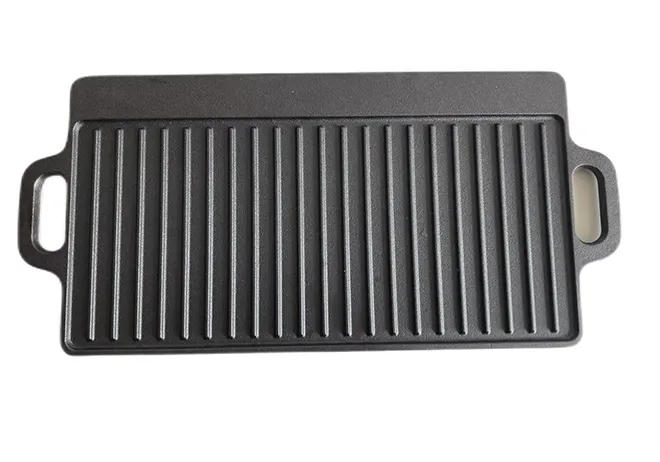
Selecting the Perfect Cast Iron Skillet for Your Cooking Needs and Style
Choosing the Right Cast Iron Skillet A Comprehensive Guide
When it comes to versatile cookware, few items are as celebrated as the cast iron skillet. Renowned for its durability, heat retention, and the unique flavor it imparts to various dishes, this trusty kitchen companion is a favorite among both amateur cooks and professional chefs. However, with so many options available on the market, choosing the right cast iron skillet can be a daunting task. In this guide, we will explore key considerations to help you make an informed decision.
1. Size Matters
The size of the skillet is one of the first factors you should consider. Cast iron skillets come in various sizes, typically ranging from 6 inches to 15 inches in diameter. A smaller skillet might be ideal for single servings or side dishes, while a larger skillet is more suited for family meals or entertaining guests. Consider what types of dishes you plan to prepare and how many people you typically cook for. A 10-inch skillet is generally a versatile option that fits comfortably on most stovetops.
2. Weight and Handle Design
Weight is another crucial factor when selecting a cast iron skillet. While heavier skillets often retain heat better, they can be challenging to handle, especially when transferring from the stovetop to the oven. If you are concerned about lifting a heavy skillet, opt for a model that is manageable for you without sacrificing heat retention. Additionally, consider the handle design. A long, sturdy handle allows for better control, while a helper handle can make it easier to carry a larger skillet.
3. Pre-seasoned vs. Unseasoned Skillets
Most cast iron skillets on the market are sold pre-seasoned, which means they come with a layer of oil baked into the surface to create a non-stick coating. This feature can save time and effort, making it easier to start cooking right away. However, unseasoned skillets provide a blank slate for those who prefer to control the seasoning process themselves. If you choose an unseasoned skillet, be prepared to season it properly before use, which can enhance its cooking performance over time.
choosing cast iron skillet

4. Brand Reputation
When selecting a cast iron skillet, brand reputation can play a significant role. Established brands like Lodge and Le Creuset have a proven track record for producing high-quality cast iron cookware. Reading customer reviews and seeking recommendations from friends can provide insights into a brand's reliability and product performance. Investing in a well-regarded brand can ensure you receive a skillet that will last for years and deliver excellent cooking results.
5. Price and Value
Cast iron skillets can vary significantly in price, depending on size, brand, and features. While it's tempting to go for the cheapest option, consider the value of your investment. A well-made cast iron skillet can provide decades of service, often improving with age. Evaluate the price in relation to factors such as durability, performance, and warranty. Sometimes spending a bit more upfront can save you money in the long run.
6. Versatility and Features
One of the main appeals of cast iron skillets is their versatility. They can be used on the stovetop, in the oven, or even over an open flame. Additionally, some skillets feature additional attributes, such as a grill or pour spouts, which can enhance their functionality. If you have specific cooking techniques in mind—like searing, baking, or frying—consider how these features may benefit your culinary endeavors.
Conclusion
Choosing the right cast iron skillet involves a careful balance of size, weight, brand reputation, and price. By taking into account your cooking needs and personal preferences, you can select a skillet that not only enhances your culinary skills but also becomes a cherished part of your kitchen for years to come. Whether you're sizzling steak, baking cornbread, or sautéing vegetables, the right cast iron skillet will elevate your cooking experience and make mealtime more enjoyable. Invest wisely, and enjoy the delicious results!
-
Season Cast Iron Perfectly with GPT-4 Turbo TipsNewsAug.01,2025
-
High Quality Cast Iron Cookware - Baixiang County Zhongda MachineryNewsAug.01,2025
-
Premium Cast Iron Pan: Durable & Perfect HeatNewsAug.01,2025
-
High Quality Kitchen Durable Black Round Cast Iron Cookware Pancake Crepe Pan-Baixiang County Zhongda Machinery Manufacturing Co., Ltd.NewsAug.01,2025
-
Cast Iron Cookware - Baixiang County Zhongda Machinery | Nonstick, Heat ResistanceNewsAug.01,2025
-
High Quality Kitchen Durable Black Round Cast Iron Cookware - Baixiang County Zhongda Machinery | Non-Stick, Heat Retention, DurableNewsJul.31,2025


